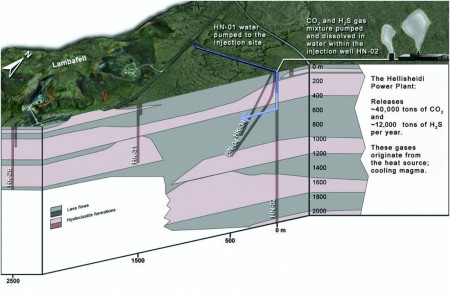June 10, 2016 – A pilot carbon capture and sequestration (CCS) project in Iceland has demonstrated the ability to mineralize carbon dioxide (CO2) within basaltic lavas and hyaloclastites (a black volcanic glass that forms in volcanic eruptions under water), putting theory into practice. Over 95% of the CO2 injected at the site in Iceland mineralized within two years. Scientists were unsure about the length of time needed for mineralizing sequestered CO2 and now have an answer. It happens much faster than what was speculated.
The project goes by the name CarbFix located about 25 kilometers east of Iceland’s capital, Reykjavik. It was designed to verify the efficacy of CCS using basaltic rock formations as the storage medium. Two injection wells were drilled to a depth of 2,000 meters (6,560 feet) near the Hellisheidi geothermal power plant. Several monitoring wells were drilled in parallel. The target basaltic layer varied in depth from 400 to 800 meters (1,300 to 2,600 feet). In Phase 1 lasting from January to March 2012, 175 tons of pure CO2 was pumped underground. In Phase 2, from June to August 2012, 73 tons of CO2 and hydrogen sulphide (H2S) was similarly stored. The ratio of CO2 to H2S was 55 tons for the former and 18 tons for the latter. H2S is a greenhouse gas.
When one thinks of geothermal power one usually doesn’t associate that this type of power source would produce greenhouse gases. But at Hellisheidi, the world’s largest geothermal site, the freshwater when injected into the subterranean volcanic heat source returns with all kinds of dissolved gases, primarily CO2 and H2S.
The relative shallowness of the target storage reservoir was an initial cause for concern about potential CO2 leaks. To counter this CarbFix uses an injection system that dissolves the gases into freshwater to create a soluble injectable. This has proven to be efficacious because the evidence shows that the CO2 immediately reacts with the basalt rather than dissolves out back into a gas.
In the illustration below, appearing in the paper published today in the journal Science, Volume 352, Issue 6291, it shows the geological cross section of the CarbFix site along with the location of the injection and monitoring wells.
The monitoring of the CO2 was accomplished using chemical and isotopic tracers, the latter possible because CarbFix laced the CO2 with Carbon-14 (an unstable carbon isotope used by anthropologists and archeologists for dating bones and ancient artifacts). Also sulfur hexafluoride and trifluoromethyl sulfur pentafluoride was added to trace migration of injected gases.
The period studied in the paper is limited to 550 days. By that point the authors write, most of the injected CO2 had mineralized. In the paper’s conclusions the authors state:
“The results of this study demonstrate that nearly complete in situ CO2 mineralization in basaltic rocks can occur in less than 2 years. Once stored within carbonate minerals, the leakage risk is eliminated and any monitoring program of the storage site can be significantly reduced, thus enhancing storage security and potentially public acceptance…..The scaling up of this basaltic carbon storage method requires substantial quantities of water and porous basaltic rocks. Both are widely available on the continental margins, such as off the coast of the Pacific Northwest of the United States.”
Turning CO2 to stone is one technological answer to the problem of anthropogenic climate change. It is one the energy industry can embrace if it so chooses. At the CarbFix site the pilot project is expanding to begin sequestering 10,000 tons of CO2 annually. Replicating a CCS project like this by the thousands at thermal power plants burning fossil fuels could prove a significant climate change disruptor. The only challenge seems to be the need for lots of freshwater, 25 tons for each ton of sequestered CO2. But Juerg Matter, the corresponding and lead author of the paper states that the CarbFix CCS technology can use seawater. That presents all kinds of additional possibilities for site deployment.















